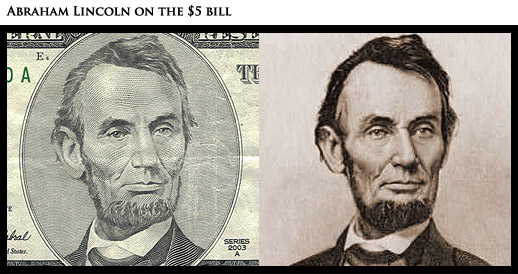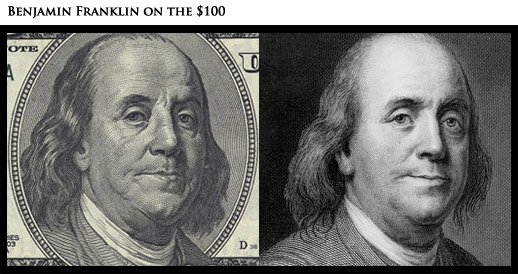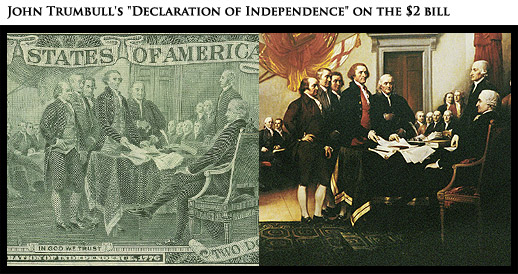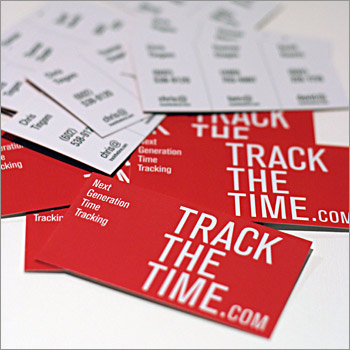“The key is to just get on the bike, and the key to getting on the bike…is to stop thinking about “there are a bunch of reasons i might fall off” and just hop on and peddle the damned thing. You can pick up a map, a tire pump, and better footwear along the way.”
— Dick Costolo, Founder of Feedburner.com
Author: Chris Tingom
Business Cards
This just in… we have business cards! Track The Time is official now, and if you’d like a card just let us know and we’ll send you a batch. We’re using them at conferences, networking events, and with our friends to spread the word about our upcoming product.
P.S. Sometime in the future, this blog design will be updated to reflect the good style we have in our cards.
U.S. Currency and the Pictures Behind The Portraits
The other night I wondered about the pictures we have on our currency and decided to research the portraits behind these pictures. Surprisingly, I couldn’t find too much collected research online and so I’ve decided to post my findings.

George Washington: Gilbert Stuart painted a number of portraits of George Washington. More than 100 in fact. One of the biggest no-nos in the design community is the horizontal flipping of photos of people. Because your face is not perfectly symmetrical, it is frowned upon as a design technique.
Despite this, our $1 bill contains a reversed picture of George Washington.
It’s really difficult to tell whether the above photo is the exact match. I have prepared two of the likeliest possible photos and matched them up so you can see how closely they match when reversed.

Abraham Lincoln: The easiest of the bunch to declare an obvious match.

Alexander Hamilton: The first Secretary of the Treasury (appointed by George Washington). The portrait is by Caroline L. Ormes Ransom.

Andrew Jackson: I bet you didn’t know that Grover Cleveland was on the $20 bill in 1914. Trivia: Jackson held an open house party where a 1,400 pound (635 kg) wheel of cheddar cheese was served as refreshment. The cheese was consumed in two hours. View full photo.

Ulysses S. Grant: This was the best photo I could find that is the exact same as the currency. It is obviously the same picture though, as you can see the hairline is the same.

Benjamin Franklin: Probably one of the coolest founding father. He wasn’t just a diplomat, but an electrical genius and very wise. This picture is inspired by an an engraving from a painting by Joseph Duplessis (1783). View full picture.


Bonus: The $2 bill is rarely used, but still printed (about 2% of all currency printed). The painting on the reverse side is John Trumbull’s “Declaration of Independence.”
Sources and larger pictures:
My Thoughts on Deadlines
For years I struggled over the concept of deadlines and wondered why it was so very difficult to meet them. And then I realized that in order to meet deadlines for software / web development projects, you really need the commitment of both the developer and the customer. You can always move the deadline, but if that’s what you want to do, at least call them milestones.
Most people suck at managing projects
Most people have more than one project going at a time, and when one deadline is moved it moves the other ones (whether you want to admit this or not).
The odds of a large project finishing on time are close to zero. — From Rapid Development (Amazon)
Today I learned that close to 25% of all airline trips are late
Wow, that’s stunning. It just goes to show that most people are optimistic and can’t even predict when a project will be done. There are countless tools that exist today to try to facilitate creating accurate estimates, but most of them are useless because we are all so busy, and a million things impact our days, thus impacting our schedules.
If missing deadlines wasn’t enough, there is a horrible failure rate in software development projects. Some people say 5 – 15% of all projects fail.
Say no, do less
Tips on the gentle art of saying no. I’m not going to comment further since I’m really bad at this.
Throw deadlines out
Stop thinking you can accurately predict the future. Give your customers a realistic expectation that you can have their project done during a window of time. You’ll quickly find that most people don’t need an exact “delivery date” for their projects. Instead they just want to know progress is being made.
I’m not suggesting that it’s good to be late on your projects, just that you accept the fact that it’s nearly impossible to meet deadlines the way you’ve been going after them, and you should change your procedure.
The deadline dance is not always productive.
Customer Service Starts with the CEO
I’ve realized something important today that I’ve known for a long time, but never really stopped to think about. Customer service starts with the founder of a company. The head honcho. The big cheese is really where it starts and ends. If the CEO of a company doesn’t care, neither will the employees.
Customer service begins at the top
I went over to The Men’s Wearhouse today, and purchased a suit. A really nice suit. I spent over $500 and walked out of there feeling like a new man. The manager of the store helped me through the process and his entire staff was behind him to help me find the best matching clothes without asking.
 The manager helped me pick out a nice navy blue suit which fits perfectly. While I was changing out of the suit, one of the other staff members picked out a series of matching shirts and ties. They had asked if I was interested, and I said I was. The whole team pulled together to make me look great, and it showed. Over 6 staff members assisted me during my brief visit (less than 30 minutes). It’s magical.
The manager helped me pick out a nice navy blue suit which fits perfectly. While I was changing out of the suit, one of the other staff members picked out a series of matching shirts and ties. They had asked if I was interested, and I said I was. The whole team pulled together to make me look great, and it showed. Over 6 staff members assisted me during my brief visit (less than 30 minutes). It’s magical.
On the radio for years I’ve heard the famous catch phrase “You’re gonna love the way you look, I guarantee it” which is uttered by the company founder, George Zimmer. It’s true. Customer service really does begin at the top.
How this applies to personal productivity
 Happy customers return, and really happy customers tell their friends. A business grows based on the service you provide and allows your company to grow, raise prices, and be the one people tell stories about.
Happy customers return, and really happy customers tell their friends. A business grows based on the service you provide and allows your company to grow, raise prices, and be the one people tell stories about.
I’m more inspired to tackle customer service again. I feel like we have okay customer service, but sometimes it can be rocky (not because we don’t care, but because we often get too busy to spend the time that great customer service requires).
Success is largely about keeping your promises
That’s how Seth Godin defines success and I think it also summarizes what it means to be good at customer service.
More reading on customer service:
- The Art of Customer Service — A very good article with 10 important things to know about good customer service.
- The Art of Customer Service, Part II — The second part of this article actually has some great tips which the first one missed.
- Return Customer — A blog about customer service, with case studies and ideas for improving customer service.
Ten High Value Uses of Your Time
Richard Koch, author of The 80/20 Principle: The Secret to Success by Achieving More with Less wrote this list of the top ten highest-value uses of your time.
- Things that advance your overall purpose in life
- Things you have always wanted to do
- Things already in the 20/80 relationship of time to results
- Innovative ways of doing things that promise to slash the time required and/or multiply the quality of results
- Things other people tell you can’t be done
- Things other people have done successfully in a different arena
- Things that use your own creativity
- Things that you can get other people to do for you with relatively little effort on your part
- Anything with high-quality collaborators who have already transcended the 80/20 rule of time, who use time eccentrically and effectively
- Things for which it is now or never
Dyson on Failure
 James Dyson created thousands of prototype vacuums over 15 years before he was satisfied with his product. In an aptly named article titled Failure Doesn’t Suck, Dyson recounts how he created the product and his thoughts on failure.
James Dyson created thousands of prototype vacuums over 15 years before he was satisfied with his product. In an aptly named article titled Failure Doesn’t Suck, Dyson recounts how he created the product and his thoughts on failure.
I made 5127 prototypes of my vacuum before I got it right. There were 5126 failures. But I learned from each one. That’s how I came up with a solution. So I don’t mind failure. I’ve always thought that schoolchildren should be marked by the number of failures they’ve had. The child who tries strange things and experiences lots of failures to get there is probably more creative.
— Sir James Dyson
“Make no little plans”
I found this quote and had to share it:
Make no little plans. They have no magic to stir men’s blood and probably themselves will not be realized. Make big plans; aim high in hope and work, remembering that a noble, logical diagram once recorded will never die, but long after we are gone will be a living thing, asserting itself with ever-growing insistency. Remember that our sons and grandsons are going to do things that would stagger us. Let your watchword be order and your beacon beauty. Think big.
— Daniel Burnham, Chicago architect. (1864-1912)
Web 2.0 Expo in SF
 I’m at the Web 2.0 Expo with the crew from Viddler, the coolest video sharing web site! If you’d like to meet me please get in touch. I’ll be here through the 18th.
I’m at the Web 2.0 Expo with the crew from Viddler, the coolest video sharing web site! If you’d like to meet me please get in touch. I’ll be here through the 18th.
This blog is devoted to our upcoming product which is a time tracking, project management web application.
Read More:
- Profile on Viddler
- Web 2.0 Expo Schedule
- BrainFuel (My main blog about web design)
- Tornado Design (Phoenix based web design consultancy)
- LinkedIn Profile
- Sign up for beta release announcement
- Videos from the Web 2.0 Expo
- While you’re here, grab our RSS Feed, thanks!
Need a Ruby on Rails Developer
Tornado Design is seeking a skilled Ruby on Rails/PHP developer that can join our team and assist us in day-to-day projects as well as our upcoming, web application!
Required Skills:
- Ruby on Rails
- Web application frontend design
- AJAX web browser client technologies, ie. Javascript, CSS, DOM+XHTML, XML, CSS, JavaScript, Web Services.
- (Prototype and Scriptaculous and others)
- Languages (in order of importance): Ruby, PHP, ActionScript, C/C++
- PostgreSQL, MySQL
- Linux and Open Source development platforms
Desired Skills:
- Distributed/Clustered (web) application development
- Any experience or familiarity with other languages such as Javascript, Actionscript, CakePHP, SmartyPHP, C++, VB, or .NET
- Mad PC/XBOX/Wii gaming skills are a plus
This is a full time position in Phoenix. Inquire within.
How to make an extra $4,687.50 this year
That’s enough to take the family on a nice vacation. Once our company switched to billing per-hour for (almost) all of our projects, our profits soared. We’re delighted because we’re now doing an amazing job tracking our time. Both billable and non billable.
The figure that I mentioned above — $4,687.50 — represents the accumulation of only an hour and fifteen minutes a week in billable hours. A paltry fifteen minutes a day, at $75 an hour, adds up to a nice vacation at the end of the year. Counting only 5 day weeks for 50 weeks a year.
Amazing, huh? Imagine what you could do if you tracked an extra hour a day.
Most companies just give away time like this. It’s too-small to track, they say. But the reality is that if you use an efficient tool for tracking time, it’s easy! And it pays off, as you can see.
Minuteglass is that tool (just wait until we launch!)
I hope that this demonstration helps you appreciate the value of tracking your time. It’s stunning, really, how most people don’t track time. If you charge your customers an hourly rate, it pays to track your time with a solid time tracking tool. It’s important to “independent agents” and also large companies of any size.
Benefits of tracking time:
- Earn more money by tracking your time better.
- Keeps you focused on your task at hand. When the clock is running, you know you need to be productive.
- Motivation: At the end of the day, if you can look at your time log and see how much you accomplished, and how much money you earned, it boosts your enthusiasm for what you do.
- It helps you estimate future projects (you can see how long a similar project took).
- Even if you don’t bill your customers an hourly rate, it’s great to know how much you work, and really know.
FeedBurner
I just signed up for FeedBurner and wanted to share my experience. It’s my first time setting a blog up to use an outside feed service, so I didn’t know exactly what to expect. But I knew that I wanted to be able to share how many subscribers we have.
Sharing the number of subscribers is one of the key things that FeedBurner provides. You can actually track how many people have subscribed to your blog. That’s very important.
I also discovered this great plugin by Steve Smith that essentially points any of your existing subscribers to your new feed url at FeedBurner. The great thing about this is that you don’t lose your existing subscribers, and you can get instant statistics about your subscribers. I am using the free version of FeedBurner. They have some extra statistics you can pay for, but I don’t need them.
I also enjoyed this screen (above) which is a good example of a “blank slate” in a web application. We’ll have to think about adding a bubble like this to our application.
Tips for Staying Organized: On Paper
Paper is great. You can easily use it to stay organized. In many ways, paper is better than any software tool for keeping up to date on your tasks. You can take it anywhere!
I present you with four links that will help you organize your projects and your life on paper.
- Moleskine PDA — Using your Moleskine notebook as a project and task organizer. Simple but clever.
- The Emergent Task Planner — An amazing paper based tool for staying on track in your day.
- Paper Prototyping — Paper prototypes invite people with little-to-no technical background into the design process.
- Remember names at meetings by making a map — Sometimes the obvious ones are the best.
My favorite tip of all time is this: Grab a sheet of paper and write down what you are going to accomplish today. Then make a new sheet every single day (or every night, before you head home).
Web 2.0 Expo
 There’s a possibility that we might be attending the Web 2.0 Expo, and if we do, we’re planning to spend some time networking with potential customers of our product.
There’s a possibility that we might be attending the Web 2.0 Expo, and if we do, we’re planning to spend some time networking with potential customers of our product.
We’re going to be attending along with several people from Viddler. The show is on April 15th through the 18th in San Francisco. It will be the perfect opportunity to hand out business cards and meet potential “early adopters” of our product, while at the same time spreading the word about Viddler.
Progress Update: Design Phase Completed
I’m please to announce that the design phase for our web application is completed. I can’t begin to tell you how enthusiastic I am about our product. The months of work that we have put into designing this application have all been worth it.
Now that it is designed, we have to develop this puppy!
I realize that a lot of people out there might be thinking about designing a web application of their own. I thought it might be useful to provide some guidelines so you know what to expect.
What to expect when designing a web app in your spare time:
- The design phase took 6 months from when we really got serious about it (August) until today (end of January) when design is done (all in Photoshop at this point).
- We worked mostly nights and weekends, with 99% all of the work being done on the weekends.
- If you figure that there were 24 weekends during this time period, and roughly 75% of those weekends were devoted to designing the application, it represents roughly 36 days of design time.
- I can’t imagine designing something like this in only 36 days. We needed a lot of time to think about what we were doing, and ponder improvements on paper throughout the week.
- That’s 288 hrs (at 8 hrs a day). I’m sure I spent more than that though.
- I discovered that gathering feedback from other people is hugely valuable but does tend to increase the number of features, which can be good (it was in our case).
- To design a rather large web application, you have to deeply care about what you are making. I could have never done this without my deep desire to get this made. I believe our product is going to change the way people track their time.
The question that obviously arises is this: Would I have been better off taking a month off of work, and focusing exclusively on our application? I don’t know the answer to that question, but I think it would have been nice (but I couldn’t do that). Plus, I needed time to think about each iteration of the design.
Next steps:
- Build the front end in CSS / XHTML and begin talking with development teams.
- Set up a bank account and talk to payment gateways.
- Finish writing initial draft of documentation for developers.
How To Figure Out Your Hourly Rate
 Freelancers and people new to the service industry ask this often enough: Should I charge an hourly rate or should I give people specific quotes?
Freelancers and people new to the service industry ask this often enough: Should I charge an hourly rate or should I give people specific quotes?
Going hourly is often the best, and the easiest since you can avoid the headache of trying to charge more when a client changes the scope of a project (that happens more often than not, in my experience).
Neil Tortorella from Creative Latitude has written an excellent guide for those thinking about billing your projects hourly. He answers the important question of how much to charge per hour to meet your profit goals.
The process to figure out your hourly rate:
- What’s your target salary? How much do you want to make in a year?
- On top of that, you’ll need to figure in other associated costs like taxes, FICA, insurance, etc.
- Total up the number of working hours available to you, subtracting vacation, sick days, and holidays
- Figure out what percentage of your day is non-billable and subtract that (typically 25% – 50% depending on a lot of factors)
- Divide your target salary by the number of working days you have
- Figure out what your overhead is, and calculate the total cost of overhead for each working hour
- The final rate is the number you’ll use to do your estimating, whether you charge by the hour or by the job. It’s the number you can’t afford to go below.
Does that make sense? Read Neil’s article for the full details.
I’ll spend some more time in the future talking about providing clients with fixed-bids, and how to avoid problems with scope creep and avoiding endless projects.
Naming This Blog
What should I name this blog? I’ve decided that I don’t want to name it “The Roundup Blog” because it’s too narrow of a definition. First time visitors to this blog will think it is all about Roundup (it will be much more than that).
For now, the new name is “Track The Time Blog.” It’s simple and based on the domain name. Maybe something more unique will present itself. Post a comment if you have a name suggestion.
I’d like to focus on creating high quality content about:
- Personal productivity
- Time tracking tips
- Time management tips
- Working with customers and clients
- Employee / employer issues
- Money management
- Creating residual income streams
- Getting things done
- Work and life balance
- Book reviews
- As well as Roundup news
The true intention really for this blog is to build a community around these topics. It will take some time before we bring this blog into full focus, but I just wanted to let everyone know of the plan! Thanks.
Round’em Up, Cowboy!
A little fun for Friday afternoon.

The Netflix Design Team on Process
“We make a lot of this stuff up as we go along. I’m serious. We don’t assume anything works and we don’t like to make predictions without real-world tests. Predictions color our thinking. So, we continually make this up as we go along, keeping what works and throwing away what doesn’t. We’ve found that about 90% of it doesn’t work.”
— Netflix Design Team (via Mister Shape)
Olaf Wieghorst, Famous American West Painter
Olaf Wieghorst (1899 – 1988) was a Famous American West painter. His artwork has been owned by the likes of U.S. Presidents Reagan, Ford, Nixon and Eisenhower; Senator Barry Goldwater, J. P. Morgan, Leonard Firestone, Gene Autry, Roy Rogers, Bing Crosby, John Wayne, Burt Reynolds and Clint Eastwood.
I won’t do a lengthy review of his work, which is amazing. I saw a few pieces at the Desert Caballeros Western Museum in Wickenburg, AZ.

“Back to the Herd” — This mounted cowboy swinging his lariat is riding hard to bring a straying horned steer back to the herd. Olaf was a master at displaying the horse in action as portrayed in this painting.



